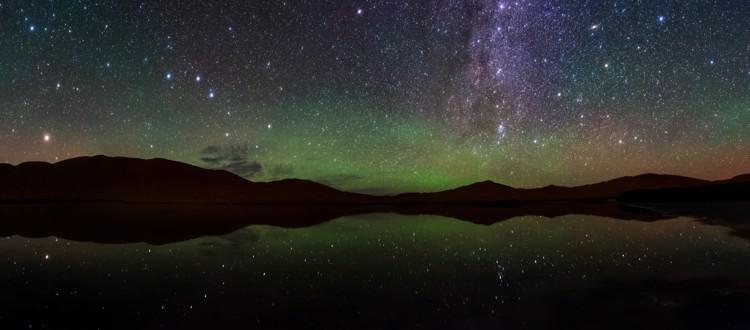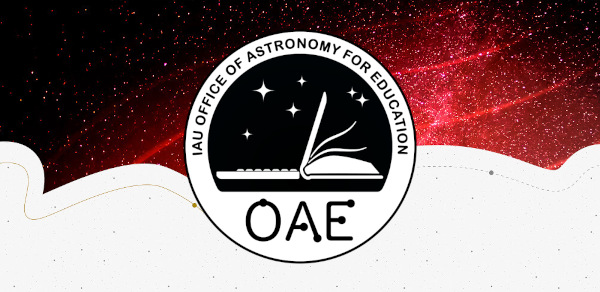This page describes an image Dreamlike Starry Sky and Airglow
Image caption:
Winner in the 2022 IAU OAE Astrophotography Contest, category Still images of celestial patterns.
This spectacular image shows a range of prominent constellations visible in the night sky over the desert of inner Mongolia, taken in August 2019. The yellowish star in the bottom left side is Arcturus, one of the brightest stars in the night sky, and the brightest in the constellation Boötes. The handle of the Big Dipper points towards this bright star and the Dipper is also visible above Boötes. The Northern Dipper (Bei Dou) is a traditional Chinese constellation. It is considered a chariot in which the Judges for Nobility are sitting. Arcturus is considered a single-star asterism, named the Horn, which forms part of the Chinese super-constellation for the spring, the Azure Dragon of the East. The front of the Northern Dipper points towards the star at the top of the photograph which is now called Polaris, the northern Pole Star. In ancient China, there was no bright star at the pole, so the stars in the nearest vicinity of the pole were considered to belong to the emperor and his family in the constellation the Purple Forbidden Palace. At least as early as mediaeval times, Polaris was considered part of the constellation of the Great Emperor of Heaven.
Corona Borealis is also visible in the top right corner of this image, although not in its completeness. It is called the Coiled Thong in China. With its characteristic semi-circular shape, this is one of the smaller constellations of the 88 modern ones, but also can be traced back at least three or four millennia through the Roman “Crown”, the Greek wedding “Wreath”, and the Babylonian “Asterism of Dignity”. The modern name literally means “Northern Crown” in Latin.
At the upper-right edge of the image, we find the part of the modern constellation Cassiopeia that is considered the Flying Corridor and an Auxiliary Road in ancient China. The W-shape of Cassiopeia is cut off by the edge of the photograph but the constellations to its south and southeast, Andromeda and Perseus, are clearly recognisable. Prominently we see the Andromeda galaxy, the most distant object that is visible to the unaided eye. It is located at the outermost outliers of the band of the Milky Way, which could explain why it has not been mentioned explicitly in ancient star catalogues, as it was mistakenly thought to be part of the Milky Way. The photograph also shows clearly reddish parts of the Milky Way that don’t appear bright to the naked eye, and also open clusters that are formed from the same molecular cloud, i.e., groups of stars with similar ages. This region is part of many big and small asterisms in traditional Chinese uranology.
Scroll to captions in other languages
Image credit:
Likai Lin/IAU OAE
DOI: 10.5281/zenodo.7425254
Related glossary terms:
Asterism
, Big Dipper
, Circumpolar Stars
, North Celestial Pole (NCP)
, Polaris
Categories:
Naked Eye Astronomy
Image license: Creative Commons Attribution 4.0 International (CC BY 4.0) Creative Commons Attribution 4.0 International (CC BY 4.0) icons
The media file captions presented on the OAE website were written, translated and reviewed by a collective effort from the OAE, the OAE Centers and Nodes, the OAE National Astronomy Education Coordinators (NAECs) and other volunteers. You can find a full list of credits for our translation project here. All media file captions are released under a Creative Commons CC BY-4.0 license and should be credited to "IAU OAE". The media files themselves may have different licenses (see above) and should be credited as listed above under "credit".
Captions in Different Languages:
Image caption: Auszeichnung beim IAU OAE Astrofoto-Wettbewerb 2022, Kategorie Weitwinkelaufnahmen von Himmelsmustern.
Dieses eindrucksvolle Bild zeigt eine Reihe von markanten Sternbildern am Nachthimmel über der inneren Mongolei, aufgenommen im August 2019. Der gelbliche Stern unten links ist Arktur, einer der hellsten Sterne am Nachthimmel und der hellste im Sternbild Bärenhüter (lat. Bootes). Die Deichsel des Großen Wagens zeigt auf diesen hellen Stern, und der Wagen ist auch rechts vom Bärenhüter zu sehen. Die Nördliche Schöpfkelle (Bei Dou) ist ein traditionelles chinesisches Sternbild. Sie gilt auch als Wagen, in dem die Richter für den Adel sitzen. Arktur ist ein aus einem einzelnen Stern bestehender Asterismus, der das Horn genannt wird und Teil des chinesischen Supersternbildes für den Frühling ist, dem Blauen Drachen des Ostens. Die Vorderseite der Nördlichen Schöpfkelle zeigt auf den Stern am oberen Rand des Bildes, der heute der Polarstern genannt wird (lat. Polaris). Im alten China gab es noch keinen hellen Stern am Himmelspol, so dass die Sterne in unmittelbarer Nähe dem Kaiser und seiner Familie im Sternbild des Verbotenen Purpurpalastes zugeordnet wurden. Zumindest im Mittelalter wurde der Polarstern als Teil des Sternbilds des großen Himmelskaisers betrachtet.
Die Nördliche Krone (lat. Corona Borealis) ist ebenfalls in der oberen rechten Ecke dieses Bildes zu sehen, wenn auch nicht in ihrer ganzen Ausprägung. In China wird sie als Gewundenes Band bezeichnet. Mit seiner charakteristischen halbkreisförmigen Form ist es eines der kleineren der 88 modernen Sternbilder, lässt sich aber auch mindestens drei oder vier Jahrtausende zurückverfolgen durch die römische Krone, den griechischen Hochzeitskranz und die babylonische "Sterngruppe der Würde".
Am oberen rechten Rand des Bildes befindet sich der Teil des modernen Sternbilds Kassiopeia, der im alten China als Fliegender Korridor und Hilfsstraße galt. Die W-Form von Kassiopeia wird durch den Rand des Fotos abgeschnitten, aber die Sternbilder im Süden und Südosten, Andromeda und Perseus, sind deutlich zu erkennen. Die Andromedagalaxie, das am weitesten entfernte Objekt, das mit bloßem Auge sichtbar ist, ist deutlich zu erkennen. Sie befindet sich am äußersten Rand des Bandes der Milchstraße, was erklären könnte, warum sie in alten Sternkatalogen nicht ausdrücklich erwähnt wurde, da man sie fälschlicherweise für einen Teil der Milchstraße hielt. Die Aufnahme zeigt auch deutlich rötliche Bereiche der Milchstraße, die mit bloßem Auge nicht hell erscheinen, sowie offene Sternhaufen, die sich aus derselben Molekülwolke bilden, also Gruppen von Sternen mit ähnlichem Alter. In der traditionellen chinesischen Astronomie ist diese Region Teil vieler großer und kleiner Asterismen.
Image credit: Likai Lin/IAU OAU
Related glossary terms: Asterismus , Großer Wagen , North Celestial Pole (NCP) , Polarstern , Zirkumpolarsterne Caption translation status: Not yet approved by a reviewer
Caption translators: Carolin Liefke
Image caption: Vincitore del concorso di astrofotografia IAU OAE 2022, categoria Immagini fisse di modelli celesti.
Questa spettacolare immagine mostra una serie di costellazioni di rilievo visibili nel cielo notturno sopra il deserto della Mongolia interna, scattata nell'agosto 2019. La stella giallastra in basso a sinistra è Arturo, una delle stelle più luminose del cielo notturno e la più luminosa della costellazione di Boote. Il manico del Grande Carro punta verso questa stella luminosa e l'Orsa Maggiore è visibile anche sopra Boote. L'Orsa Maggiore (Bei Dou) è una costellazione tradizionale cinese. È considerato un carro su cui siedono i Giudici della Nobiltà. Arturo è considerato un asterismo a stella singola, chiamato Corno, che fa parte della super-costellazione cinese della primavera, il Drago Azzurro dell'Est. La parte anteriore dell'Orsa Maggiore punta verso la stella in cima alla fotografia, oggi chiamata Polaris, la stella polare. Nell'antica Cina non esisteva una stella luminosa al polo, quindi le stelle più vicine al polo erano considerate appartenenti all'imperatore e alla sua famiglia nella costellazione del Palazzo Proibito di Porpora. Almeno fin dall'epoca medievale, Polaris era considerata parte della costellazione del Grande Imperatore del Cielo.
Anche la Corona Boreale è visibile nell'angolo in alto a destra di questa immagine, anche se non nella sua completezza. In Cina è chiamata Laccio arrotolato. Con la sua caratteristica forma semicircolare, è una delle costellazioni più piccole delle 88 moderne, ma può essere fatta risalire ad almeno tre o quattro millenni fa attraverso la "Corona" romana, la "Ghirlanda" nuziale greca e l'"Asterismo della dignità" babilonese. Il nome moderno significa letteralmente "Corona del Nord" in latino.
Sul bordo superiore destro dell'immagine, troviamo la parte della moderna costellazione di Cassiopea che è considerata il Corridoio Aereo e una Strada Ausiliaria nell'antica Cina. La forma a W di Cassiopea è tagliata dal bordo della fotografia, ma le costellazioni a sud e sud-est, Andromeda e Perseo, sono chiaramente riconoscibili. In primo piano si vede la galassia di Andromeda, l'oggetto più lontano visibile a occhio nudo. Si trova ai margini più esterni della fascia della Via Lattea, il che potrebbe spiegare perché non è stata menzionata esplicitamente negli antichi cataloghi stellari, in quanto si pensava erroneamente che facesse parte della Via Lattea. La fotografia mostra anche parti chiaramente rossastre della Via Lattea che non appaiono luminose a occhio nudo, e anche ammassi aperti formati dalla stessa nube molecolare, cioè gruppi di stelle con età simili. Molti asterismi grandi e piccoli dell'uranologia tradizionale cinese fanno parte di questa regione..
Image credit: Likai Lin/IAU OAU
Related glossary terms: Asterismo , Grande Carro , Polaris , Polo Nord Celeste (NCP) , Stelle circumpolari Caption translation status: Approved by a reviewer
Caption translators: Giuliana Giobbi
Caption reviewers: Rodolfo Canestrari









